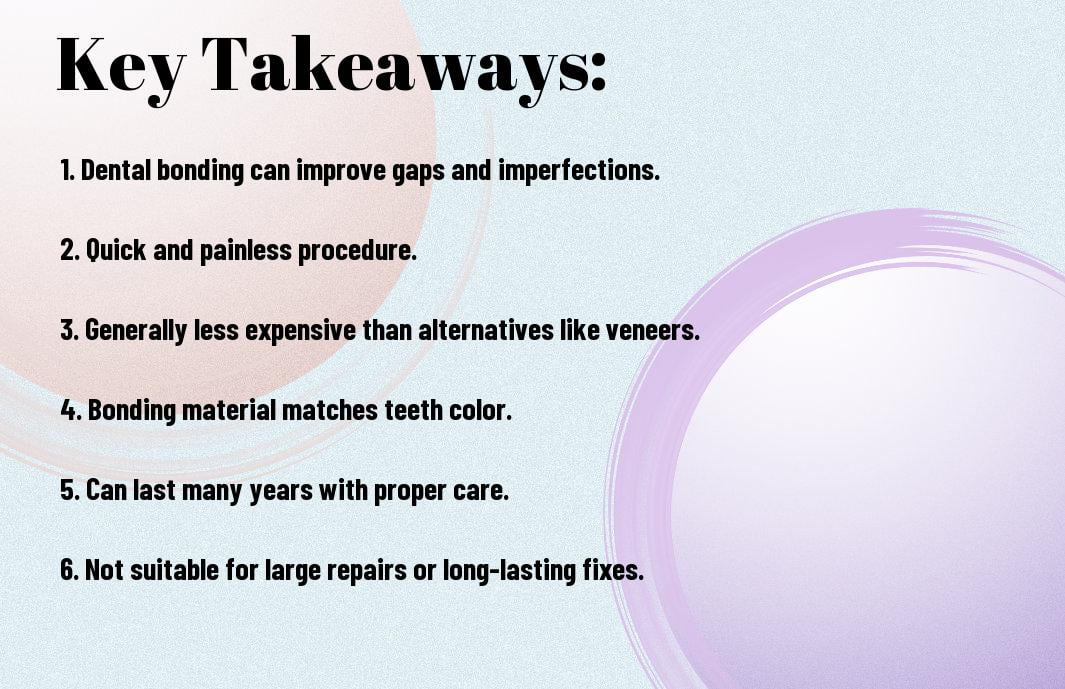It’s common to desire a flawless smile, but imperfections like chips, cracks, or gaps can hinder your confidence. Dental bonding offers a quick, effective solution to address these issues without invasive procedures. This procedure involves applying a tooth-colored resin to the affected areas, which is then shaped and hardened to blend seamlessly with your natural teeth. Not only does dental bonding improve the appearance of your smile, but it also provides strength and durability to the treated teeth. To learn more about how dental bonding can fix minor imperfections and gaps in your smile, check out Fix Minor Imperfections in Your Smile With Dental Bonding.
Key Takeaways:
- Dental bonding is a versatile solution that can address imperfections such as chipped, stained, or gapped teeth.
- During the procedure, a tooth-colored resin material is applied to the tooth and shaped to achieve the desired look, providing a natural appearance.
- Dental bonding is a cost-effective and relatively quick cosmetic procedure that can enhance your smile with long-lasting results.
What is Dental Bonding?
Definition and Overview
To understand dental bonding, it is important to know that it is a cosmetic dental procedure used to improve the appearance of teeth by closing gaps, repairing chips, and fixing discoloration. Bonding involves the application of a tooth-colored resin material to the tooth surface, which is then hardened using a special light, bonding the material to the tooth.
Materials Used in Dental Bonding
Bonding materials typically consist of a resin composite that is durable and tooth-colored, making it blend seamlessly with natural teeth. The resin is moldable and can be shaped to match the contours of the tooth, allowing for a custom fit. This flexibility makes it an ideal choice for fixing minor imperfections.
The Dental Bonding Procedure
Initial Consultation and Examination
Examination: Assuming you have decided to undergo dental bonding to address imperfections or gaps in your teeth, the first step is an initial consultation with your dentist. During this consultation, your dentist will examine your teeth to determine if dental bonding is the right solution for you.
Preparation and Application Process
Examination: Once the decision is made to proceed with dental bonding, your dentist will begin the preparation process by lightly etching the surface of your tooth and applying a conditioning liquid. This helps the bonding material adhere properly to your tooth.
Understanding: The next step involves your dentist applying the tooth-colored, putty-like resin to your tooth. The resin is molded and smoothed to the desired shape before being hardened with a special light.
Curing and Finishing Touches
Examination: After the resin has hardened, your dentist will further trim and shape it to blend seamlessly with your natural teeth. Once the desired shape is achieved, the bonded area is polished to match the sheen of the surrounding teeth.
With proper care and maintenance, dental bonding can last several years, providing a cost-effective solution for minor cosmetic issues. It is important to note that while durable, bonded teeth can chip or stain, so avoiding hard foods and staining agents can help prolong the lifespan of the bonding.
Benefits and Limitations of Dental Bonding
Advantages of Choosing Dental Bonding
For individuals looking to enhance their smile, dental bonding offers a cost-effective solution with immediate results. This procedure is versatile and can address various cosmetic concerns such as chipped teeth, gaps, discoloration, and misshapen teeth. Dental bonding is a minimally invasive treatment that typically requires only one visit to the dentist.
Considerations and Longevity
Dental bonding is a popular choice for many patients, but it’s vital to understand the limitations associated with this treatment. While bonding material is durable, it is not as strong as natural teeth or other restorative options like dental crowns. Plus, bonded teeth are prone to staining and may require touch-ups or replacements over time.
Despite its limitations, dental bonding can be a valuable solution for minor cosmetic issues. It’s vital to consult with your dentist to determine if bonding is the right choice for your specific needs.
Care and Maintenance of Bonded Teeth
Daily Oral Hygiene Practices
For optimal oral health and the longevity of your bonded teeth, it is crucial to maintain a diligent oral hygiene routine. Brush your teeth twice daily with a soft-bristled toothbrush and fluoride toothpaste. Flossing once a day will help remove plaque buildup in hard-to-reach areas, preventing gum disease and decay around the bonded teeth.
Professional Follow-up and Dental Visits
Professional dental visits every six months are crucial for monitoring the condition of your bonded teeth. Your dentist will examine the bondings for any signs of wear, chipping, or staining and address any issues promptly. Regular check-ups also allow your dentist to assess your overall oral health and recommend any necessary treatments to maintain the integrity of your smile.
Practices such as avoiding chewing on hard objects like ice or pens, as well as refraining from biting on non-food items, can help prevent damage to the bonded teeth. If you notice any changes in the appearance or feel of your bonded teeth between dental visits, contact your dentist immediately for further evaluation and care.
Conclusion
To wrap up, dental bonding is a versatile and effective solution for correcting imperfections, gaps, and minor dental issues. With its ability to enhance the appearance of teeth while preserving their natural structure, bonding offers a quick, cost-effective, and minimally invasive option for achieving a beautiful smile. By understanding the process and benefits of dental bonding, individuals can make informed decisions about their oral health and work towards a confident and radiant smile.
FAQ
Q: What is dental bonding?
A: Dental bonding is a cosmetic dental procedure in which a tooth-colored resin material is applied and hardened with a special light, bonding it to the tooth to improve the appearance of chipped, stained, or misaligned teeth.
Q: What imperfections can dental bonding correct?
A: Dental bonding can be used to repair chipped or cracked teeth, close gaps between teeth, reshape teeth, and make teeth appear longer. It is also commonly used to cover stains on teeth and improve the overall appearance of a smile.
Q: How long does dental bonding last?
A: With proper care, dental bonding can last anywhere from 3 to 10 years. However, it is important to avoid habits that can damage the bonding material, such as biting on hard objects or using teeth to open packages. Regular dental check-ups and professional cleanings can help maintain the longevity of dental bonding.







